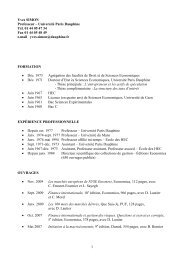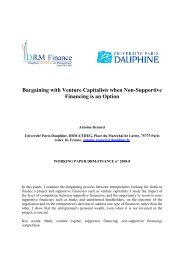Souad AJILI - CEREG - Université Paris-Dauphine
Souad AJILI - CEREG - Université Paris-Dauphine
Souad AJILI - CEREG - Université Paris-Dauphine
You also want an ePaper? Increase the reach of your titles
YUMPU automatically turns print PDFs into web optimized ePapers that Google loves.
Introduction<br />
The Capital Asset Pricing Model CAPM ( Sharpe (1964), Lintner (1965), Mossin<br />
(1966) and Black (1972)) is the first and the most widely used model of asset<br />
pricing because of its simplicity. It assumes that investors respect the Markowitz<br />
mean-variance criterion in choosing their portfolios. The beta revolution has had<br />
significant impact on the academic and non-academic financial community. Other<br />
factor pricing models attempted to explain the cross-section of average asset returns<br />
[The Inter-temporal Capital Asset Pricing Model ( Merton (1973)), The Arbitrage<br />
Pricing Model ( Ross (1976)) and the inter-temporal capital asset pricing model<br />
based on consumption ( Rubinstein (1976), Lucas (1978), Breeden (1979), among<br />
others 1 )].<br />
The well-known prediction of the CAPM is that the expected excess return on<br />
an asset equals the β of the asset times the expected excess return on the market<br />
portfolio, where the β is the covariance of the asset’s return with the return on<br />
the market portfolio divided by the variance of the market return. Roll (1977)<br />
argued that the model is not testable because the tests involve a joint hypothesis<br />
on the model and the choice of the market portfolio. On the other hand, many<br />
patterns emerge from empirical studies which are not explained by the CAPM; such<br />
as: expected returns and earnings to price ratio have a positive relation ( Basu<br />
(1977)), small capitalisations have higher expected returns than big capitalisations<br />
( Banz (1981)), there is a positive relation between the level of debt and stock returns<br />
( Bhandari (1988)) and the book to market ratio is considered as an explanatory<br />
variable in stock returns ( Chan et al. (1991) and Fama and French (1992) on<br />
Japanese and American markets respectively).<br />
In our study, we compare the Three Factor Asset Pricing Model of Fama and<br />
French (1993) and the Characteristic Model of Daniel and Titman (1997) in explaining<br />
stock returns in the case of France. Fama and French argue that stock returns<br />
can be explained by three factors: market, book to market ratio and size. Their<br />
model summarizes earlier results ( Banz (1981), Huberman and Kandel (1987),<br />
Chan and Chen (1991)). However, it is much debated: To be a compensation for<br />
risk in a multi-factor version of Merton’s (1973) Inter-temporal Capital Asset Pricing<br />
Model (ICAPM) or Ross’s (1976) Arbitrage Pricing Theory (APT), factors must<br />
be related to state variables which justify a risk premium.<br />
A competing model of the three factor model of Fama and French is the model<br />
of the characteristics of the firm of Daniel and Titman (1997). Indeed, Daniel and<br />
Titman give a different interpretation for the relation between book to market ratio<br />
and stock returns. They reject the assumption of “factor of risk” in favor of the<br />
model of “the characteristics of the firm”: A low book to market ratio, which is<br />
one of the characteristics of the large firms, causes a low stock returns which does<br />
not, necessarily, correspond to a risk. They show the superiority of their model in<br />
comparison to that of three factors of Fama and French. However, Davis et al.<br />
1 Cochrane (2001)documented that: ≪...all factor models are derived as specializations of the<br />
consumption-based model. Many authors of factor model papers disparage the consumption-based<br />
model, forgetting that their factor model is the consumption-based model plus extra assumptions<br />
that allow one to proxy for marginal utility growth from some other variables.≫ p151<br />
2



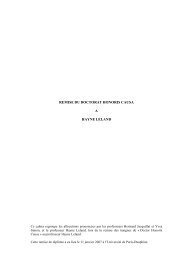

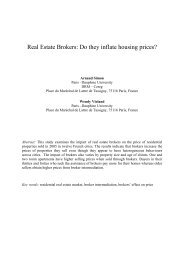
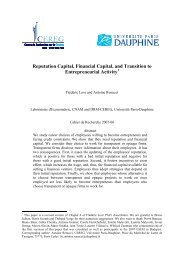

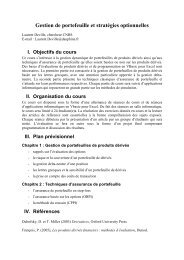

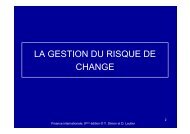
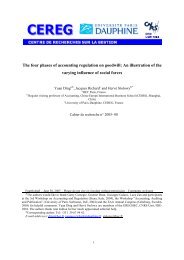
![& 6 ] ^ F ]^ - CEREG - Université Paris-Dauphine](https://img.yumpu.com/33326502/1/184x260/-6-f-cereg-universitac-paris-dauphine.jpg?quality=85)

